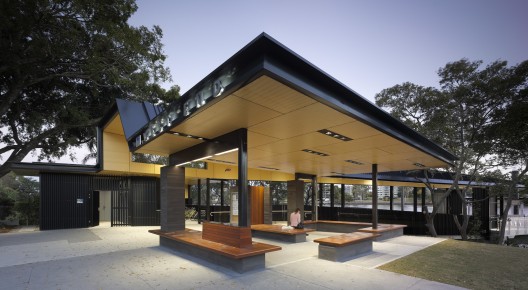The West End Ferry Terminal is a small project that was designed to simultaneously generate a new typology for Brisbane’s Citycat Terminals and act as a sheltered social gathering space at the end of one of Brisbane’s historic riverfront parks, one endeared in the hearts of the West End community.
The terminal simply responds to its core role as conduit from bus station to ferry pontoon, rising as a spinal volume to accentuate its connectivity. The spine slopes and angles to correspond with the journey, its form wrapping out into lower scaled wings which accommodate seating, cycle and public amenities. Both its daytime shade-providing form and its contrasting illuminated night-time character have become emblematic of West End, for which the terminal has become its community’s most beloved social space.
Conceptual Framework
West End Ferry Terminal was conceived as a sequence of sheltered spaces rising as a spine corresponding with street-pontoon movement along its centre and winging out along its edges into compressed social and amenity spaces. These edges were designed to create a layering of scales with minimal impact upon Orleigh Park. A series of devices – frames, furnishings, signs and lighting – were conceived to create the impression of a canopied outdoor ‘living room’ for the community, and simultaneously a legible form for accessing Citycat timetables, arrivals and departures.
The terminal is designed in contrast with previous standard terminals along the Brisbane River in its sensitive siting to context, particularly in this case where it required community support and endorsement to proceed, such were the communities concerns in relation to Orleigh Park. The siting includes avoidance of interference with a significant fig tree and insertion within the river mangroves averting any disturbance.
The terminal utilises low embodied energy materials and is designed to maximise both solar and storm protection. The canopies and furniture also foster-social interaction as distinct from the terminal’s transport access role. Vandalism risk was taken using recycled hardwood as an environmentally sustainable material, however social sustainability is evidenced by it incurring no damage at all. Although a small open-sided facility, it incorporates rainwater collection that flushes toilets and waters surrounding landscape.





